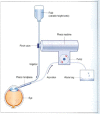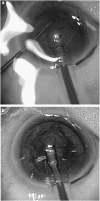Fluidics and rheology in phaco surgery: what matters and what is the hype?
- PMID: 29350690
- PMCID: PMC5811741
- DOI: 10.1038/eye.2017.299
Fluidics and rheology in phaco surgery: what matters and what is the hype?
Abstract
Rheology can be defined as the study of materials flow behaviour under applied deformation forces (stresses). Inside the eye during cataract surgery, transient or reversible deformation (elasticity) and permanent or irreversible deformation (flow) can both apply. Although the fluidics of modern phaco machines is an important part of this talk, there are a number of issues relating to flow and fluids in the eye during cataract surgery, which are unrelated to the machine, which can hinder or help the operating surgeon in removing a cataract. In addition, coping with the numerous complications, which can occur in the eye at the time of surgery, relies on an understanding of how fluidics and rheology can help to control the pressurised eye and bring the surgery to a successful conclusion.
Conflict of interest statement
The author declares no conflict of interest.
Figures





References
-
- Newton’s Principia: The Mathematical principles of Natural Philosophy Sir Isaac Newton 1686.
-
- Cionni RJ, Barros MG, Osher RH. Management of lens-iris diaphragm retropulsion syndrome during phacoemulsification. J Cataract Refract Surg 2004; 30(5): 953–956. - PubMed
-
- Packard RB. Avoiding lens-iris diaphragm retropulsion syndrome. J Cataract Refract Surg 2010; 36(7): 1245. - PubMed
-
- Liyanage SE, Angunawela RI, Wong SC, Little BC. Anterior chamber instability caused by incisional leakage in coaxial phacoemulsification. J Cataract Refract Surg 2009; 35(6): 1003–1005. - PubMed
-
- Day AC, Donachie PH, Sparrow JM, Johnston RL Royal College of Ophthalmologists' National Ophthalmology Database. United Kingdom National Ophthalmology Database Study of Cataract Surgery: Report 3: Pseudophakic Retinal Detachment. Ophthalmology 2016; 123(8): 1711–1715. - PubMed
MeSH terms
LinkOut - more resources
Full Text Sources
Other Literature Sources

